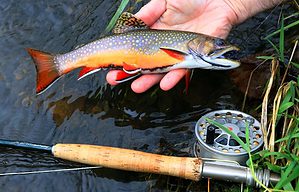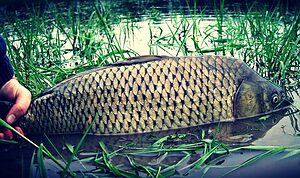Disclosure: Some posts contain affiliate links, which earn us a commission if you make a purchase through them. Positive Fishing © participates in various affiliate networks including the Amazon Services LLC Associates Program.
- Catch and release is a very important part of fishing.
- Learn what the regulations on catch and release are.
- Understanding the factors to ensure fish return healthy back to the water.
Catch and release fishing is a technique practised by anglers where their catch is returned to the water. All of us anglers must help maintain and encourage the growth of fish stocks in the waters we fish.
By following some simple guidelines, the fish will continue to reproduce and enhance the fish ecosystem.
In this article, I will cover the key techniques and the important regulations around catch and release.
Objectives Behind Catch And Release Fishing

Certain lakes and rivers are under a certain amount of pressure to keep fish stocks healthy and growing. Whilst anglers do not impact the stocks as much as disease or overfishing; there is still a big part we can play every time we go fishing.
Catch and release can minimize stress on certain species, their habitat, and the fish ecosystem. The angling community adopts many methods to conserve the ecosystem.
Many global angling organisations specify minimum and maximum size thresholds for fishing. Therefore, to comply with these fishing ethics, many anglers practice catch-release techniques voluntarily.
Techniques For Catch And Release Fishing:
Successful catch-and-release fishing also depends on four critical factors in which every angler can significantly reduce fish damage.
Tackle Choice
Using a strong rod and line to land and catch the fish. They should be strong enough to reduce lengthy playing and landing times. A fish on the line for a long time creates a stressed and tired fish.
Always use small, single, and barbless hooks. Treble hooks should only be used when live or dead baiting for pike fishing. Barbed and treble hooks can cause severe injuries if the angler is not experienced.
Barbless hooks or micro barbs are readily available in all tackle shops.
Artificial baits (plastic-based) should never be used as feeder bait or free offerings. Only use them as hook bait.
Be alert for bites when fishing, and do not leave your rod unattended. Fish will often swallow the bait if you are not paying attention to your float or other bite indicators.
Landing The Fish
Once a fish is near the bank and is ready to be landed, make sure you use a suitable landing net for a fish of reasonable size. Do not lift a fish up and out of the water if it is too large.
A landing net reduces the fish from mouth damage; if the hook slips out from its mouth, it prevents it from landing on a hard surface. This causes serious injuries to the fish’s body. Always use a fine mesh net made from rubberized or polyester netting, and never use a knotted net.
These nets make it faster and easier to unhook and protect the fish’s body from any scrapes or knicks.
Handling The Fish
Fish handling is a crucial step. The least amount of time out of the water is a priority.
Always make sure that your hands are wet before handling any fish to protect the fish’s protective layer of mucus (slime)
Where possible, leave the fish in a landing net whilst unhooking or with your hand/s beneath the belly area.
Never hold a fish by its gills. Instead, handle the fish lightly without squeezing its body.
If your fingers cannot unhook the fish, use proper fishing forceps to remove the hook. If the hook is set too deep, always use a disgorger. If the hook cannot be retrieved in very rare cases, carefully cut the line as close to the hook as possible but do not remove the hook.
For more details on fish handling, please look at my article on handling and holding fish the right way.
Releasing The Fish
When fishing in a river, release the fish by holding it in an upstream-facing position or using your landing net. Let the fish naturally swim away from you, supporting it in a gentle current. A slower current helps fish regain their strength and catch their breath.
If you are fishing in a lake, allow the fish plenty of time to rest before the fish swims away on its own.
Is Catch And Release Good For Fish?
As an angler, I believe this is the best and most favoured method. Catching fish and killing them does not allow the natural process of growth to continue.
You can read my article on what percentage of catch-and-release fish die here! Where I discuss the topic in great depth.
Sea And Sports Fishing Regulations For Anglers
Sports fishermen also practice catch-release techniques to preserve pressured or endangered species such as Swordfish and Marlin. Once caught, these fish are almost always returned to the water.
Anglers also release fish they do not intend to eat, and those are not their target species. When catching too many fish, anglers will typically release any extra fish back into the water, especially when they do not have suitable storage or retention facilities.
Rivers And Lake Fishing Regulations For Anglers
In the UK, anglers have been practising catch and release methods for many years. Most coarse fish are not caught and eaten at the table, with the main exception being trout and salmon.
There are regulations that are in place to restrict the quantity and size of any fish an angler can take from the water.
This is slightly different in the United States, where the catch-and-release guidelines are not always so tightly regulated, and each state has different rules. Some states are very rigid, but others are not.
European countries generally have no catch-and-release regulations; only private fisheries will have specific rules that must be applied.
Government Guidelines And Regulations On Fishing
General provisions under the UK laws of the SEA are rather long and detailed. You can find a copy here https://www.legislation.gov.uk/ukpga/1981/29/section/45.
Under the UK Freshwater fishing laws, there are regulations on the daily catch limits and sizes. The full list can be found at this link: https://www.gov.uk/freshwater-rod-fishing-rules/fish-size-and-catch-limits.
Tip: Trout and salmon regulations differ from coarse fish and vary by local area.
In European countries, the regulations are covered under a “common fisheries policy” at the following link: https://ec.europa.eu/oceans-and-fisheries/policy/common-fisheries-policy-cfp_en.
Angling Clubs And Fishery Guidelines For Anglers
All angling clubs in the UK will ensure compliance with these rules. Fisheries may also apply more stringent rules in addition to the UK general regulations.
Failure to comply will result in a club or fishery ban or even the police being notified. You can also be fined if you remove fish from privately-owned waters without written permission from the owner.
Unfortunately, some people either do not know the rules or choose not to follow them. Carp, specifically in the UK, are prone to be taken by some anglers for the eating table, which in the UK is illegal.
Fish Species, Water Temperature, And Water Depth Impact On Fish

A successful catch and release and survival of fish depend on many factors. A few other criteria also play a major role.
Large-scaled species like bass and carp have been shown to have higher survival rates. On the other hand, some mackerel species have low survival rates even with proper atmospheric and fishing conditions.
In the same manner, lower survival rates are observed in high water temperatures and hot weather conditions.
Water depth also plays an integral role in determining the survival success ratio. For example, fish undergo ‘swim bladder expansion’ due to a significant pressure change when caught from deep water. This damage caused to fish is known as barotrauma, and such fish are unlikely to survive release practice.
Final Thoughts
I am a big advocate of catch and release. Over 50 years of fishing, having any fish, big or small, not recovering from being caught is never a happy one. As anglers, we must ensure we do our best to minimize or prevent any stress, and trauma fish may encounter.
Educating beginners and following the basics I have outlined above can play a major part in practising catch and release correctly.
If you liked this article and want to learn more about being a responsible angler, please read more of my other fish care articles here!
- 5 Best Fishing Bags For Getting Your Gear Organized - January 13, 2025
- 4 Essential Surf Fishing Rigs - January 11, 2025
- How To Know The Sex Of A Fish You Have Caught? - December 9, 2024

